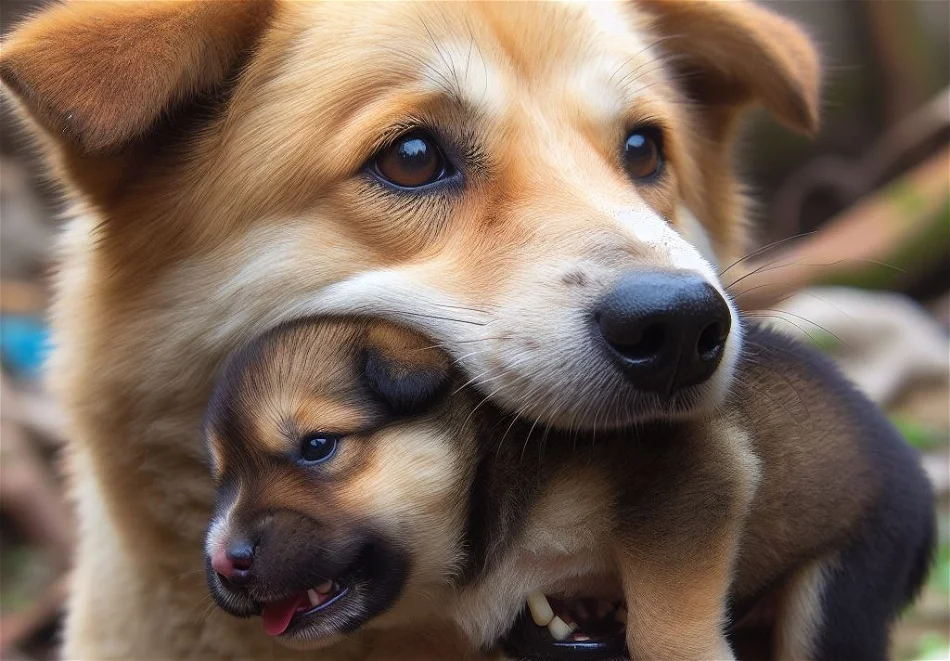Why male dogs kill puppies, for many dog owners this is still a great truth to know, the phenomena of male dogs killing puppies can be startling as well as confusing. To protect all canines in the home, it is imperative to understand the fundamental reasons of this behavior. This thorough book will cover the scientific, evolutionary, and behavioral elements of male dogs acting aggressively against puppies and offer management and preventative techniques.
Causes of Male Dogs Killing Puppies
- Absence of Paternal Instincts: Unlike female dogs, male canines are not always very instinctive parents. Puppy aggressiveness can result from this uncaring attitude, particularly if the male dog views the puppies as rivals for resources or attention.
- Resources Competition: Male dogs may become aggressive when they are vying for territory, food, and attention. Puppy households can have aggressive behavior from males that view the young ones as rivals for little resources.
- Health Problems and Pain: Pain and health problems can have a big impact on a dog’s behavior, much like they can on a human. A medical problem that causes a male dog to be uncomfortable or in pain can show itself as hostility against puppies.
Behavioral Patterns
In observing male dogs, several behavioral cues can signal aggression towards puppies. Growling and snarling serve as vocalizations indicating the dog’s sense of threat or defensiveness. Alongside these auditory warnings, bared teeth are a physical display of aggression, often paired with a stiff body posture and raised hackles. This stiff body language, typically accompanied by a heightened alertness, further underscores the dog’s aggressive stance. Additionally, lunging or snapping actions can pose significant risks, not only for the puppies but also for the male dog itself, highlighting the urgency of addressing and managing such aggressive behaviors promptly.
Prevention and Management
Early socialization plays a pivotal role in mitigating aggression towards puppies in male dogs. Through exposure to diverse environments, individuals, and other animals from an early age, dogs develop crucial social skills and learn appropriate behaviors. Furthermore, consistent training efforts aimed at teaching male dogs to respond to commands and respect boundaries contribute significantly to aggression prevention. Moreover, addressing any underlying medical issues is paramount in improving the overall behavior of the dog, potentially alleviating aggressive tendencies. Patience and consistency are key throughout this process, as it may take time for the male dog to acclimate to new dynamics and adopt peaceful coexistence with the puppies through persistent efforts and positive reinforcement.
Instinctual Behaviors Inherited from Wild Ancestors
Like their wild forebears, male dogs have instincts that affect how they treat pups. Strongly ingrained in the canine’s evolutionary past, these instincts greatly influence how they behave. Male dogs were in charge of defending and making sure the pack survived in the wild. Sometimes this protective tendency shows itself as unanticipated behaviors, such hostility toward puppies, because they put the safety of the group first.
Role of Testosterone in Aggression and Territoriality
Dogs among many other species have been associated with strong aggressive reactions triggered by the hormone testosterone, which is produced in the testes. Considering that males of many animals battle for access to pregnant females, the strong association between aggression and testosterone is not unexpected. In dogs, testosterone levels can influence aggression through both activational and organizational effects. Activational effects refer to the reversible influences of testosterone on aggression in adult animals, while organizational effects describe the lasting effects of early exposure to gonadal steroids on the development of brain structures controlling aggression.
In dogs, testosterone can elicit territorial behavior, which is a key element in understanding their behavior towards puppies. Territoriality is a natural instinct that can lead to aggression when a dog perceives a threat to its territory or pack. This instinctual behavior is inherited from wild ancestors and plays a significant role in shaping the dog’s actions.
Breeding Methods’ Effect on Behavior
Dog behavior can be greatly impacted by breeding methods, especially with regard to territoriality and aggression. Dogs may develop these tendencies, for instance, if breeding methods that stress particular characteristics—like aggression or dominance—are used. Aggression in progeny can also be increased by breeding methods that provide preference to choosing dogs with aggressive tendencies.
In Pack Mentality and Dominance Hierarchy
Within the field of dog social dynamics, the idea of a dominance hierarchy is hotly contested. A common viewpoint holds that dogs, like wolves, function in a rigid hierarchical system where hostility is reduced by strong, steady, and obvious leadership. This perspective has been called into question, nevertheless, by recent research that contends the conventional idea of dominance hierarchy is oversimplified and does not adequately capture the intricate social dynamics found in dog packs.
Actually, a number of elements, including heredity, socialization, resources available, fear, disputes, learning, behavioral disorder, and sickness, affect the more complex social dynamics of dogs. Scientific data refutes the idea that dogs are inherently competitive and that this rivalry fuels hostility.
Competition for Resources, Including Mates and Territory
Competition for resources, including mates and territory, is a natural aspect of canine social dynamics. However, this competition is not necessarily driven by a desire for dominance but rather by the need to ensure survival and well-being. In the context of a household, competition for resources can manifest in various ways, such as competition for food, attention, or space.
Behavior Effects of Socialization and Training
The way that dogs behave in a home is mostly shaped by socialization and training. Dogs who receive appropriate socialization can pick up vital abilities and behaviors including collaboration, communication, and dispute resolution. Dogs can be taught desirable behaviors and behavior issues can be avoided with the use of positive reward, operant conditioning, classical conditioning, desensitization, and counter-conditioning training techniques.
Environmental Stressors and How They Affect Behavior
A dog’s behavior can be greatly impacted by environmental stresses, which can enhance their uneasiness and hostility. Many things can add to dogs’ increased stress levels and possible aggression, including noise pollution from fireworks or thunderstorms, routine changes like moving to a new house, social isolation from insufficient social interaction, and physical environment conditions like being confined to small spaces or exposed to extreme temperatures.
Aggression-Induced by Anxiety and Its Expressions
Aggression brought on by anxiety can show out as defensive, offensive, or fear-based aggression in dogs. When dogs sense threat, fear-based aggressiveness usually results, and they react aggressively to protect themselves or to get away from those they regard as threats. Conversely, when dogs feel cornered or threatened, defensive aggression shows up, frequently manifesting as more difficult and intense behaviors. Furthermore, dogs who have had bad experiences in the past could exhibit offensive fear aggression, going for triggers and acting aggressively and threateningly as a kind of defense.
The Value of Giving Dogs a Secure Environment
Reducing stress and anxiety in dogs requires providing them a safe and secure environment. It comprises:
- Making a Comfortable Home: Stress and anxiety can be greatly reduced by making a dog’s home clean, comfortable, and stress-free.
- Creating a Regular Schedule: Dogs who have a regular daily schedule feel more secure and predictable, which helps to lower tension and anxiety. Adequate social interaction and exercise can help dogs feel less stressed and anxious.
- Handling Noise Pollution: Dog tension and anxiety can be lessened by using calming aids or white noise generators to handle noise pollution.
- Handling Subtle Problems: Professional training and behavioural modification can help dogs with subtly problematic problems like fear-based aggression or separation anxiety.
Conclusion
In summary, it takes a multidimensional approach to comprehend why male dogs kill puppies. In male dogs, biological causes include a lack of paternal instincts, resource competition, and health problems can all lead to hostility. A dog’s behavior can also be greatly influenced by environmental stresses like noise pollution and routine changes as well as social dynamics like pack mentality and dominance hierarchy. These elements must be identified and addressed via early socialization, training, and giving dogs a secure environment. By acting thus, we can guarantee the safety and well-being of every dog in the home and greatly lower the possibility of violence in male dogs.

